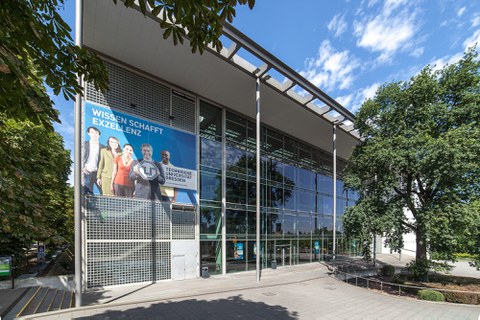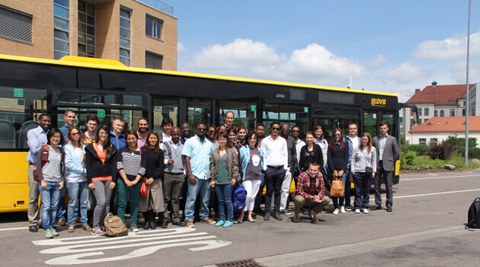Things to know
In this section, our current and future students can get first information about the TUD Dresden University of Technology , our facilities at CIPSEM, the City of Dresden and its surroundings.
TUD Dresden University of Technology

Main auditorium of the TU Dresden
The Technische Universität Dresden (TUD, Dresden University of Technology) — one of the oldest technical universities in Germany — is a German elite university and is justifiably proud of its fine tradition in education. The buildings and institutes cover approximately 275 hectares and form an integral part of the city of Dresden, just south of the city centre. lf you add the extended area of the Faculty of Medicine located in another part of town with its numerous hospitals, the university is even bigger. Originally founded as a technical school in 1828, it was awarded the status of a Technical Academy in 1890 and in 1961 it was recognized as a University of Technology. Since the German reunification in 1990, new faculties have been added to the traditional faculties of sciences and engineering. These include economics, humanities, social sciences and medicine. As a result, the range of research possibilities and courses now offered by TUD is extremely broad and quite unique in Germany.
The University Library (SLUB)

TU Dresden library
The Saxon State and University Library Dresden (SLUB) was created through the merger of the University Library of the TUD Dresden University of Technology and the Saxon State Library in 1996. With nearly nine million exemplars, it is one of the largest libraries in Germany. The Central Library is located in Zellescher Weg 18, very nearby the CIPSEM facilities and open Monday to Saturday from 8am until midnight (service: 9am-6pm), as well as Sunday from 10am until 8pm (no service). Besides, there are also several branch libraries focusing on special topics, such as e.g. the Branch Library of Forestry in Tharandt.
The SLUB is freely accessible by everyone without registration and can be used by the CIPSEM participants as a reference library. In addition, the SLUB also has some special treats to offer: It also houses the Book museum & and treasure room. The entrance is free and visitors can see — among other collections — the famous Maya-Code (Codex Dresdensis), which is the oldest and best preserved Maya book and one of only three remaining and assuredly authentic manuscripts of the Maya. Every Saturday at 2pm, free guided tours are offered.
University Canteen (Mensa)
The 'Studentenwerk Dresden' runs 12 canteens (called 'Mensa') and six smaller cafeterias at different locations in the city. The offered meals are subsidized and usually cost between 2-3 € for TUD Dresden University of Technology students and also for the CIPSEM course participants. The canteen closest to the CIPSEM facilities is the 'Mensa WU1'. With 77 seats and 200-250 served lunches per day, it is one of the smaller canteens. It offers two different dishes to choose from, one of them vegetarian. Besides, there is also a fresh salad buffet.
What's on the menu in the student restaurants? Please find the latest menu here.
CIPSEM Facilities

The CIPSEM building
The CIPSEM facilities are located in the southern part of the city, about 1 km west of the TUD Dresden University of Technology main campus. Apartments, staff offices and teaching facilities are all in one building and create a pleasant learning environment with short distances. The building at Zellescher Weg 41c belongs to the so called 'Student city' Wundtstraße/Zellescher Weg which offers living space for 1600 students of the TUD Dresden University of Technology and the HTW Dresden. Green spaces, sport facilities, canteens and the Saxon State and University Library Dresden (SLUB) are to be found in close proximity.
Most of the lectures are given in our lecture room at Zellescher Weg 41c. It offers space for all the participants and also has various devices and tools for presentations, workshops, or group work available. Some lectures take place at the respective institutes of the TUD Dresden University of Technology.
Our library contains various specialist literature and publications about all topics relevant to our course contents. Moreover, we also offer some textbooks to improve your German language skills and in case you need a break from studying, we have also some novels available. All books can be borrowed by our course participants free of charge.
Our clubroom offers a cosy atmosphere for watching movies, gatherings with your course mates or simply to relax.
Our course participants are all accommodated in our comfortable private studio apartments with ensuite bathroom. The apartments are fully equipped with kitchen and furniture.
The City of Dresden
All courses of CIPSEM take place at Technische Universität Dresden (Dresden University of Technology) in Germany. Dresden is situated between 51° and 52° Northern latitude in the temperate zone. The coldest months are November, December, January and February, with mean temperatures of 0 °C to +1 °C, although temperatures as low as -10 °C may occur. Dresden is the capital city of the Free State of Saxony and has a population of 573.648 inhabitants (by 12/2024). It is situated on the river Elbe, has become famous above all as a city of the arts, and is only a two-hour drive away from Berlin to the north and Prague to the south.
Dresden first acquired influence and importance during the reign of two monarchs, Friedrich August I., called “Augustus the Strong”, and his son Friedrich August II. During the late 17th and the first half of the 18th century, these two members of the dynasty of Wettin initiated the creation of those magnificent baroque buildings and unique collections of art that helped the capital of Saxony to attain the designation “German Florence.”
Towards the end of World War II, the town was almost completely destroyed. Some buildings are still scarred from the war, however, numerous historical buildings have been restored. All prominent towers of the famous city silhouette are again mirrored in the waters of the river Elbe.
How to get around:
By public transport:
The municipal transport system of Dresden is run by the 'Dresdner Verkehrsbetriebe' (DVB). The tram network in Dresden comprises 12 tram lines with a total line length of around 200 km and 154 tram stops. Furthermore, there are 28 bus lines with a line length of around 300 km and three ferries crossing the River Elbe. 152 Million passengers are transported per year.
All participants are supplied with transit passes for the public transport which allow for the use of all trains, trams, buses, and ferries within the Dresden fare zone. Connections, timetables, and ticket prices can be looked up on the website of the DVB. Apps for mobile devices are also available.
By bicycle:
Bicycles are becoming more and more attractive as means of transport for inner-city distances. In the past decade, the share of cyclists has doubled to more than 16% of the total traffic of Dresden. In the same period, the total length of distances travelled by bike has even tripled. 380 km of bicycle lanes (marked red or with a bicycle symbol) run along the main roads. In side roads, a speed limit of 30 km/h increases the safety for cyclists and makes the bike an environmentally friendly, healthy, cost-effective, flexible and time-efficient transport option.
The course participants can rent bikes from CIPSEM for a small royalty.
Sights and Culture

Old town skyline of Dresden
Dresden is a world-class city of arts and culture and as such has a lot to offer. Over 50 museums are hosted in the city, approaching among others various historical topics, natural history, music, literature, arts, and technologies (List of museums in Dresden). More than 35 theatre stages show performances from operas and concertos for orchestras to cabarets and rock concerts. A special experience is the visit of the famous Semperoper, the opera house of the Saxon State Opera. It is the concert hall of the Saxon State Orchestra and home of the Semperoper ballet. The historic centre offers many sights within walking distance, such as:
- The Frauenkirche (Church of Our Lady).
- The Dresden Zwinger: hosting among other exhibitions the Old Masters Picture Gallery.
- The Residenzschloss (Royal Palace): hosting five museums, among others the Historic Green Vault (Europe's most extensive jewels collection) and the Türckische Cammer (Turkish Chamber, one of the oldest and most important collections of Ottoman art anywhere in the world outside Turkey).
- The Semperoper: beside various performances, guided tours in English are offered.
- The Fürstenzug (Procession of Princes): the largest porcelain artwork in the world (101 m long, painted on more than 24.000 tiles of Meissen Porcelain).
- The Katholische Hofkirche (Dresden Cathedral of St. Trinitatis): the most important Catholic Church in the city and the cathedral of the Roman Catholic Diocese Dresden-Meißen was built from 1739 and 1755 in Baroque style. The heart of King Augustus the Strong is buried in the crypt.
- Brühlsche Terrasse (Brühl's Terrace): also named 'The Balcony of Europe' is a former fortification wall. Underneath is the Dresden Fortress, which is considered to be the oldest preserved part of the city and can be explored on tours with audio guide.
North of the historic centre, the River Elbe loops through the city. The Augustus Bridge is the oldest bridge in Dresden and connects the historic centre with the northern part of the city called Neustadt (new town). Several cultural institutions and museums are located nearby the Neustadt river bank, such as:
- The Japanisches Palais (Japanese Palace): Baroque-style building which host the Ethnological Museum and the Senckenberg Natural History Museum.
Dresden Surroundings
Dresden is just within a stone's throw from the low mountain range “Saxon Switzerland” a part of the Elbe Sandstone Mountains, a paradise for hikers, rock-climbers and every nature lover. The unusual sandstone rocks are a favourite target for free climbers, and if that happens to be your hobby, be sure to bring along your equipment to Dresden. The forests and pastures on either side of the river offer plenty of ordinary hiking trails, linking castles, country inns, and scenic views.




